The Three Types of Cataracts and What you should be on the Lookout For
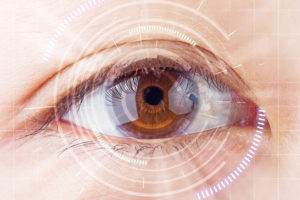
Most people over the age of 40 that suffer vision loss are developing cataracts. Cataracts are the leading cause of blindness throughout the entire world. The number of cases of cataracts far eclipse the amount of glaucoma, macular degeneration and diabetic retinopathy cases combined!
There are three types of cataracts:
- Subcapsular Cataracts: Occurring at the back of the lens. These are most common in people who have diabetes or are regularly taking high doses of steroid medications.
- Nuclear Cataracts: Formed deep in the nucleus of the lens. This type of cataract is generally associated with aging.
- Cortical Cataracts: These tend to occur in the lens cortex—a part of the lens that encompasses the central nucleus. This type of cataract is generally known for its opaque wedge shapes that begin forming in the periphery of the lens and gradually move in towards the center.
According to Prevent Blindness America (PBA) as it stands right now, more than 22 million Americans age 40 and older are suffering from cataracts of some form. By the year 2020, this number is expected to rise to as many as 30 million!
To put it simply, cataracts are when your eye’s natural lens begins to cloud. Here are some early warning signs you might want to be on the lookout for if you are age 40 and above:
- Vision beginning to blur slightly
- Light sensitivity
- Increasing levels of glare from oncoming headlights when driving at night
- Colors appear to be dull
- Seeing “halos” around light sources
- Double vision in one of your eyes
Depending on the type of cataract you have started to develop you might not experience any symptoms or in some rare cases your near vision can actually improve temporarily. It is important to remember that cataracts generally develop slowly and won’t dramatically affect your vision early on.
If you believe you are beginning to develop a cataract, make sure to set up an appointment immediately so we can be sure, and begin planning your treatment.
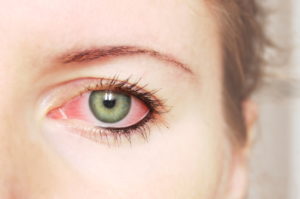
Allergies tend to be associated with a runny nose, scratchy throat, or just an increased level of sneezing, but allergy symptoms come in a lot of different varieties. Unfortunately for many, allergies can cause all types of discomfort for the eyes, ranging from swelling to a persistent itchy feeling.
If you find that your eyes are getting red, swollen, and/or itchy—then it is highly possible that it is due to an allergy pollen, pet dander, dust, freshly cut grass, etc… In order to rid yourself of this frustration you need to figure out what is triggering your reaction and take action to stay ahead of the symptoms.
Eye allergies, or “allergic conjunctivitis” as it is known in the scientific community, is caused by a misfiring of the immune system—like any other allergic reaction. When you have an allergic reaction, your body is reacting to something that isn’t really harmful and releases histamine—a chemical that causes swelling and inflammation. With eye allergies this makes the blood vessels in your eyes swell, making them get teary, red, and itchy.
The different types of eye allergies are as follows:
- Perennial conjunctivitis: These allergies are year-round and can be triggered by dust, pet dander, and other indoor allergens.
- Seasonal allergic conjunctivitis: The most common type of eye allergy, which can be triggered by pollen from grass, weeds, and trees.
- Contact Conjunctivitis: This can be triggered by makeup, perfume, or other chemicals.
- Giant Papillary Conjunctivitis: This is a very specific allergy type that is triggered by contact lenses.
While most of the time allergic symptoms will materialize pretty quickly, it can sometimes take up to two to four days to make themselves known after exposure. Here are some allergy symptoms to keep an eye out for:
- Sensitivity to light
- Itchy eyes
- Soreness, burning, or pain
- Red irritated eyes
- Swollen eyelids
- Tearing or runny eyes
In most cases, eye allergies can be treated by over-the-counter eye drops and antihistamine pills. The best thing you can do to minimalize the effects of your allergies is to be aware of them and to take all the necessary precautions to limit exposure. If eye problems persist and over-the-counter medications aren’t providing relief, be sure to see your eye doctor for further inspection.

Wildfires can be an issue anywhere when there isn’t enough rain during the hot summer. If you live in California, then you most likely already know the dangers these wildfires pose to the ecosystem and neighboring towns. A lesser known fact about fire is that the smoke can be equally as detrimental to your health as the fire itself. Exposure to smoke can cause damage to your lungs, but did you that smoke can damage your eyes as well?
Exposure to smoke on any level can cause irritation to your eyes—symptoms such as burning sensations, redness, and tearing up are commonplace with smoke exposure. Robert N. Weinreb MD, a distinguished Professor of Ophthalmology at the University of California San Diego, claims that “even a healthy person’s eyes can be bothered” when it comes to smoke exposure and, particularly in the case of those with dry eye syndrome, “exacerbate symptoms.”
What causes this irritation is the existence of small particles, which are two and one half microns or less in size (for reference: 25,400 microns = 1 inch), within the smoke that get stuck in your eyes. These particles are too small to be seen with the naked eye. These particles can remain floating in the air long after the smoke has cleared, so if you are around fire or a place where large amounts of fire have been recently, many firefighters recommend the use of protective eyewear.
Most of time eye irritation from smoke can be cured with the use of over-the-counter artificial tears and the use of a cold compress, but if your eyes remain irritated for longer than a few days you should consult your eye doctor.
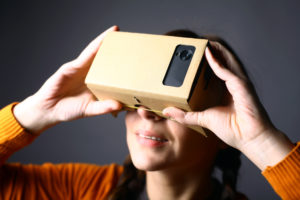
In most cases, the first thing that comes to mind when you think of virtual reality headsets is their function in the wonderful world of entertainment. Virtual reality is considered the new frontier of the entertainment world, but could there be more to the technology than meets the eye?
Amblyopia, or “lazy eye,” occurs when one of your eyes vision is so weak that your brain fails to recognize the eye is even there. This ends up messing with your depth perception quite a bit. There is a belief that if you fail to correct this issue before the age of 8, then it will be irreversible. Now thanks to virtual reality, this belief has been challenge.
James Blaha suffered from lazy eye for the majority of his life and because of this, he had lost the ability to judge distance. Conventional treatment methods such as: glasses with different color lens, and forcing the lazy eye to see by covering up the strong eye failed to work. Despite these failed attempts at treatment James did not give up hope for corrected vision.
After some research into the field of optometry, James came up with an idea. Using the virtual reality Oculus rift developers kit James began experimenting with a 3D cube. He adjusted the brightness settings of the Oculus by raising the brightness of the screen facing his lazy high and lowering the brightness of the screen facing his strong eye. What he discovered was that this forced his brain to use that weak eye more and made the cube appear in 3D.
James continued to experiment with this idea, and after three weeks of doing this he noticed an improvement in his vision. Today, James claims to have 90% of his depth perception restored to his lazy eye, and is looking to bring this approach to treatment to many others.
So, will we be seeing Oculus VR headsets being used to treat amblyopia around the globe? It remains to be seen if this method will work for everyone who suffers from amblyopia, but the initial testing done by James, looks promising.
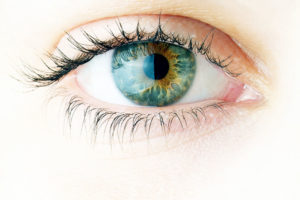
Diabetes is a growing issue throughout the world, with an estimated 382 million people suffering from it in 2013. If not treated, diabetes can lead to other serious medical complications such as: ischemic heart disease, kidney failure, heart attack, and stroke—but did you know that diabetes can also affect your eyes?
According to the American Optometric Association, diabetic retinopathy is a condition that “causes progressive damage to the retina.” The leading cause of blindness in the United States is attributed to this disease.
If you have diabetic retinopathy it is very difficult to regulate and requires a lot of extra care. Properly adhering to a good diet will help to mitigate the damages to your eyes, but a good diet alone will not be enough to ensure healthy eyes. Just because you aren’t suffering from eye pain, does not mean you don’t need medical attention.
Diabetic retinopathy is unpredictable, making follow-up care all the more important to maintain good visual health. Always be sure to regularly go in for checkups with your eye doctor as symptoms aren’t always easily detected.

There are a lot of different foods out there that help to promote good eye health, but how many do you know about? In this article we talk about some of these foods and how they can be beneficial to your daily diet.
Orange Vegetables
I’m sure you remember at least one person telling you when you were a child that “you need to eat your carrots because it’s good for your eyes!” The reason we were all told this as children is that carrots and other orange vegetables contain high levels of beta-carotene, a type of vitamin A that plays a key role in powering your vision. It is also no coincidence that all orange vegetables are good for your eyes, because beta-carotene is also what makes vegetables have an orange hue.
Leafy Greens
This is a very broad category, essentially if it’s a vegetable and its green chances are it has got lutein and zeaxanthin in it. Lutein and zeaxanthin are carotenoids—a class of more than 600 naturally occurring pigments synthesized by plants—that help filter out harmful blue wavelengths of light. Lutein and zeaxanthin are the only carotenoids that are deposited in high quantities in the retina of the eye. Leafy greens act as an antioxidant of sorts for your eyes which helps to prevent macular degeneration and cataracts. So make sure not to forget to eat your spinach!
Eggs
The yolk of an egg is high in lutein, zeaxanthin, and zinc. We discussed the benefits of lutein and zeaxanthin above, but zinc is another nutrient that is considered to be good for your eyes. Much like lutein and zeaxanthin, it said to help prevent macular degeneration and cataracts, but as an added benefit it can also help with night blindness.
Citrus
Oranges and grapefruits are just a couple of the citrus fruits out there that are jam packed full of vitamin C. Why is this important for eye health? Because vitamin C does a lot more than just help you get over the common cold. Virtually every cell in the body depends on vitamin C, this includes those of the eye. It helps support the health of your ocular blood vessels. Having a little citrus every day can help prevent age-related macular degeneration and glaucoma.
Blueberries
Within these little berries lies: vitamin C, vitamin A, vitamin E, and zinc. Some could consider the blueberry to be a “jack of all trades” in regards to the nutrients it provides.
- Vitamin C, as discussed above, is said to help prevent glaucoma and age-related macular degeneration
- Vitamin A (which beta-carotene stems from) can help prevent dry eyes, and generally promotes good eye health
- Vitamin E may help prevent the formation of cataracts and the clouding of the eye lens
- Zinc, as discussed above, can help protect your eyes against macular degeneration and glaucoma, as well as reduce night blindness
Blueberries are great antioxidants for your entire body, and they are fantastic in a bowl of cereal.
Almonds
One handful of almonds (approximately an ounce) provides about half of your daily vitamin E. As covered in the blueberry portion of this article; Vitamin E can help prevent the formation of cataracts and the clouding of the eye lens.
Fatty Fish
This may not sound the most appetizing, but you might be surprised to learn that some of the post popular fish out there are fatty fish. Tuna, salmon, mackerel, anchovies, and trout are all considered to be fatty fish, making them rich in docosahexaenoic acid (DHA)—an omega-3 fatty acid that is a primary structural component of the retina. If you suffer from low levels of DHA in your diet, you might have issues with dry eye syndrome.
So there you have it! While including all of these foods into your diet may not ensure perfect eye health, the fact remains that eating healthy does help to ensure a better quality of life.

Most people know to protect themselves from Ultraviolet (UV) rays using traditional sunblock because of increasing skin cancer awareness. It is a less common understanding when it comes to the dangers UV radiation poses to your eyes, but like skin cancer awareness, it is becoming a growing concern around the world. It is good to see a raised level of awareness surrounding these issues, but in regards to how and when you should protect yourself from the dangers of UV radiation, there are some common misconceptions.
Here are a few common misconceptions regarding UV safety you should look out for:
- UV rays remain a danger during all seasons of the year. Dangerous UV rays can still penetrate moderate, overcast cloud cover, mist, and fog.
- Natural light isn’t the only type of light that can be dangerous to your skin and eyes. Artificial rays produced from tanning beds and some plant grow lights can produce the same amounts of UV-A and UV-B rays that are produced by the sun.
- Just because you aren’t looking up at the sky doesn’t mean your eyes aren’t being affected by harmful UV rays. UV rays bounce off most things, even if the object in question doesn’t appear to be reflective. To name a few examples: sand, water, snow, metals, bright colors etc…
- Not all sunglasses protect your eyes from the sun; only sunglasses labeled “100% UV protection” protect you from harmful UV-A and UV-B rays.
So, regardless of the weather, be sure to make it a part of your routine before going outdoors to always keep that sunblock handy, wear a hat, and to not forget your 100% UV protective sunglasses.
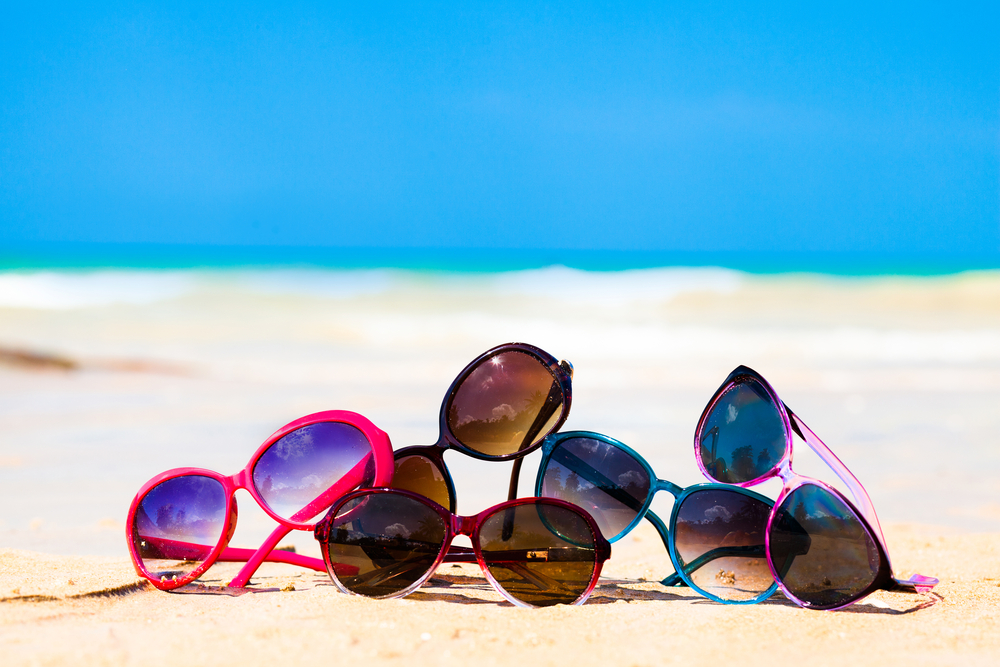
Sunglasses can give you instant James Dean cool or Audrey Hepburn glamour, but they’re much more than just a fashion accessory. Sunglasses are an essential tool in safeguarding the health of your eyes. Sunglasses provide critical protection from the sun’s damaging ultraviolet (UV) rays. Long term exposure to UV rays can damage the surface of your eye as well as its internal structures — sometimes contributing to macular degeneration and cataracts.
Here are a few things to keep in mind when shopping for a new pair of sunglasses this summer.
Look for Complete UV Protection
Don’t be fooled by the color or cost of a certain pair of sunglasses. Choose a pair that provides full protection against ultraviolet light. The ability to block UV light is not dependent on the darkness of the lens or the price tag attached to a particular pair of shades. Instead look for a label or sticker on the pair that you’re planning to purchase that says one or more of the following:
- Lenses block 99% or 100% of UVB and UVA rays
- UV 400 protection (This means the lenses block light rays with wavelengths up to 400 nanometers, which means that your eyes are shielded from even the smallest UV rays.)
- Lenses meet ANSI Z80.3 blocking requirements. (This refers to standards set by the American National Standards Institute.)
Ensure Sunglasses Block Enough Light
Sunglasses should screen out 75-90% of visible light. You can test to see if a particular pair of sunglasses is dark enough by trying them on in front of a mirror. If you can see your eyes easily through the lenses, they’re probably too light.
Choose Wraparounds
Wraparound styles of sunglasses offer bonus protection from the sun’s UV rays. Sunglasses that wrap around the temples prevent the sun’s rays from entering from the side. Some studies have shown that enough UV rays enter around standard sunglasses frames to reduce the protection offered by their lenses.
Check the Quality of the Lenses
Look for a uniform tint on the lenses making sure that one area is not darker than another. You can check for imperfections in the lenses by holding the glasses at arm’s length and looking through them at a straight line in the distance, such as the edge of a door. Slowly move the lens across the line of the door. If the straight edge distorts, sways, moves or curves, then the lens is flawed.
Eye Safety
It’s always important to remember that even the best pair of sunglasses cannot protect your eyes from certain intense light sources. Tanning lights, snowfields, arc welding or gazing directly at the sun (even during a solar eclipse) require special protection beyond that of sunglasses to prevent damage to your eyes.
Special Features
You may also want to take the time to consider which special features you may want or need when purchasing a new pair of shades.
- Mirror coatings – Thin layers of various metallic coatings on lenses can reduce the amount of visible light that enters your eyes. These types of lenses are popular in high-glare environments and when combined with the wraparound feature, they can provide added protection to the skin surrounding your eyes.
- Gradient – These lenses are permanently shaded from top to bottom or from top and bottom toward the middle. Single gradient lenses – which are dark on top and lighter on the bottom – can cut glare from the sky, but still allow you to see clearly below the gradient – this is especially good for driving, but not as helpful in the snow or on the beach. Double-gradient lenses – which are dark on top and bottom and lighter in the middle – may be better for sports where light reflects up off water or snow such as skiing or sailing.
- Polarized – Polarized lenses cut reflected glare, which is what occurs when sunlight bounces off smooth surfaces like water or pavement. These lenses can be especially helpful when driving, boating or out in the snow. Polarization is unrelated to UV protection so you will still need to ensure UV absorption of your lenses even if they’re polarized.
- Photochromic – This is a type of lens automatically darkens in bright light and becomes lighter in low light. Although photochromic lenses may be good UV-absorbent sunglasses (again, the label should specify this), it can take a few minutes for them to adjust to different light conditions.
- Impact Resistant – While all sunglasses must meet minimum FDA standards in regards to impact resistance, no lens is truly shatterproof. Plastic lenses are less likely to shatter upon impact than glass lenses and polycarbonate plastic, which is used in many sports sunglasses, is even more impact resistant that regular plastic. However, polycarbonate lenses scratch very easily. If you purchase a pair of polycarbonate lenses, be sure to look for ones that have scratch-resistant coating.
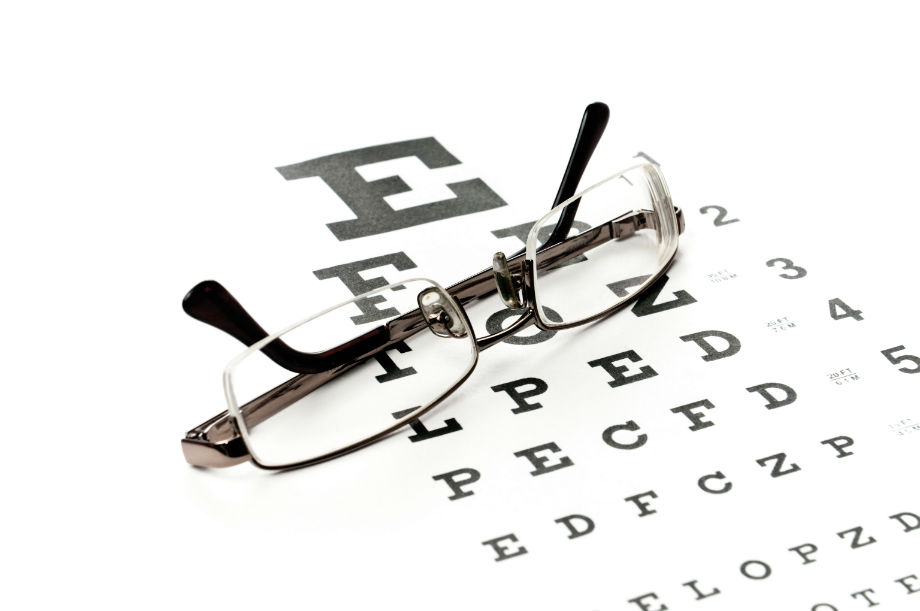
Taking care of your eyes should be a priority just like eating healthy and exercising regularly. When it comes to our health, we often visit our physician to ensure that our bodies are healthy. But what about when it comes to the health of our eyes? They’re not always top of mind, but they’re definitely just as important.
During Healthy Vision Month, which is celebrated each year during the month of May, we encourage you to make your eye health a priority by educating yourself on ways to protect your vision.
Ways to protect your vision
- Schedule regular comprehensive dilated eye exams.
- Eat right to protect your sight! Incorporate lots of dark leafy greens such as kale and spinach into your diet as well as fish that is high in omega-3 fatty acids like salmon, trout and halibut.
- Know your family’s eye health history. It’s important to know if anyone if your family has been diagnosed with an eye disease or condition since these can sometimes be hereditary.
- If you smoke, quit. Smoking increases your risk of developing cataracts and age-related macular degeneration.
- Wear protective eyewear when participating in certain sports or activities such as yard work, painting, and home repairs.
- Wear sunglasses that block 99 to 100% ultraviolet A (UVA) and ultraviolet B (UVB) radiation.
- If you wear contacts, make sure to wash your hands before removing your lenses and to cleanse them properly to avoid infection.
These simple steps can help prevent vision loss and even blindness. You’ll help to ensure your eyes are healthy and that you’re seeing well for a lifetime!

Some eye conditions are hereditary, but many are a result of poor vision care and bad habits. You may be surprised to find that things you do each and every day might actually be damaging your eye sight.
Here are a few bad habits that you should break in order to protect your vision for years to come.
Not Wearing Your Sunglasses
When you forget to wear your sunglasses you’re exposing your eyes to the sun’s harmful UV and high-energy visible (HEV) rays which can prematurely age and damage your eyes and eyelids. Long periods of exposure can lead to sunburn on the front surface of the eye (photokeratitis), macular degeneration, cataracts, pinguecula and pterygium; and in some cases, cancer of the eyelid. To protect your eyes be sure to wear sunglasses that block 100% of the sun’s UV rays. And don’t forget to wear them whenever you’re outdoors – even on overcast days.
Smoking
Smoking harms almost every part of your body – including your eyes. Research has linked smoking to eye diseases such as macular degeneration, dry eyes, cataracts, uveitis, and diabetic retinopathy. Smokers are four times more likely to lose their vision compared to people who do not smoke. The good news is that quitting, no matter what your age, can help reduce your risk of developing a serious eye condition.
Rubbing Your Eyes
The skin around your eyes is very delicate. Rubbing your eyes can actually break the tiny blood vessels that are under the skin’s surface and cause dark circles or a puffy appearance. Regular eye rubbing over an extended period of time can lead to a condition known as keratoconus. Keratoconus causes a thinning of the cornea and results in the cornea losing its shape. This condition can lead to blurry vision and sometimes cannot be fully corrected with glasses or contact lenses.
Not Getting Enough Sleep
It’s called beauty sleep for a reason: not getting enough rest can cause red, bloodshot eyes as well as dark circles, eye twitches, dry eyes and blurry vision. Not getting enough rest not only affects your vision, but it can affect your overall health as well.
Not Eating Properly
If you aren’t incorporating enough fruits and vegetables into your daily diet then you’re probably not getting the necessary vitamins, minerals, and fatty acids necessary for optimum eye health. A diet rich in colorful fruit, leafy greens, and fish are all essential to keeping your vision healthy. Eating properly can help prevent or manage many age-related eye diseases.
Not Drinking Enough Water
Not drinking the recommended 8 glasses of water per day and eating a high-sodium diet can cause your body to become dehydrated, and in turn may cause your eyes to not produce enough tears to keep them moisturized and properly nourished. Dry eyes, red eyes and puffy eyelids can all be a result of dehydration.
Not Having Regular Eye Exams
Comprehensive eye exams can detect vision problems, eye diseases, and general health issues before you even realize that they exist. Routine eye exams are especially important because certain vision-stealing diseases such as glaucoma often have no warning signs until there is a permanent, irreversible loss of vision. Be sure to alert your doctor of your family’s eye health history to help determine whether you are at high risk for a particular eye disease of condition. The key to good eyesight is proper eye care so don’t forget your regular eye exams.
